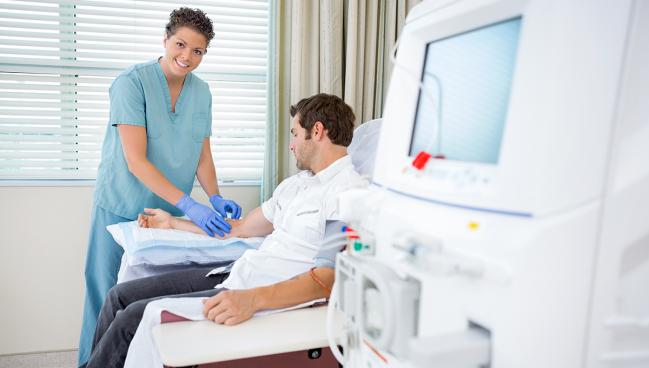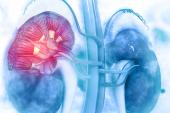AHA Urges More Home-Based Dialysis in Advanced Kidney Failure
There are no large outcomes trials, but at-home dialysis can improve BP and LV mass, a statement concludes.

In a scientific statement published this week in Circulation, the AHA says there is enough evidence showing that these home-based therapies can improve cardiovascular risk factors—and potentially outcomes—compared with traditional dialysis performed three times a week in a healthcare setting.
“Cardiovascular disease is the primary adverse outcome in dialysis patients, so finding alternative and better ways of treating them is obviously important,” Mark Sarnak, MD, MS (Tufts University Medical Center, Boston, MA), chair of the committee that drafted the new statement, told TCTMD. “We recognize that traditional in-center dialysis three times a week puts a lot of stress on the cardiovascular system.”
The statement lines up with new policies from the American Kidney Health Initiative, including an executive order focused on kidney health and disease signed by the prior presidential administration in 2019. In addition to the stated goal of reducing the number of patients with end-stage renal disease (ESRD) by 25% by 2030, the order also emphasized the need for more flexible treatment options, such as home-based dialysis.
“This was also an ideal opportunity to collaborate with the AHA to emphasize disparities in kidney disease and suggest ways to reduce these disparities,” said Sarnak. Given that there are now some clinical trials in this space, along with the policies from the American Kidney Health Initiative, it was a good time to move ahead with the statement, he added.
Improving Surrogate Endpoints
In-center hemodialysis performed three times per week for 3 to 5 hours per session is the most common treatment for patients with kidney failure. Outcomes remain poor, however, with the annual risk of death approximately 15% in such patients. With traditional hemodialysis, patients can experience cycles of hypervolemia, which can lead to cardiovascular problems, including hypertension, greater LV mass, LV remodeling, and other adverse effects on cardiac structure and function. Sarnak said there is evidence showing that home-based therapies can result in a “more physiological approach” by avoiding the rapid changes in volume associated with traditional, thrice-weekly hemodialysis.
“For home hemodialysis, there is randomized, controlled data showing better blood pressure control, decreased left ventricular mass, decreased left ventricular volumes, decreased use of antihypertensive medications, and better control of certain solutes such as phosphorus, and so on,” he said. “We don’t have the large, randomized trials like those in the cardiovascular field with changes in mortality and cardiovascular outcomes, but we clearly have some suggestion home hemodialysis improves multiple surrogates of cardiovascular disease.”
Commenting on the AHA document for TCTMD, Gihad Nesrallah, MD, MSc, MBA (Humber River Hospital, Toronto, Canada), agreed that the bulk of the trial evidence in this space, particularly for home hemodialysis, has looked at physiological or surrogate outcomes—improvements in blood pressure control, regression of ventricular hypertrophy, and better volume management—whereas support for an impact on hard outcomes has come largely from observational studies.
“It's been very difficult to conduct trials comparing various dialysis modalities,” he said. “There have been a lot of attempts over the years, but it's been very difficult to do these trials. So there is some uncertainty, but there is still a strong, physiological rational for promoting more intensive dialysis, and I think there's definitely an important role for cardiologists to play in helping to promote home therapies.”
Low US Uptake
In the US, home dialysis rates are low, with 11.2% doing peritoneal dialysis and just 1.9% doing home hemodialysis.
Peritoneal dialysis, which involves an indwelling catheter so that sterile solutions of varying dextrose concentrations can be infused into the abdominal cavity, is an option over bloodstream-based ultrafiltration and for select patients may be particularly attractive, such as those with heart failure, LVADs, ascites, pulmonary hypertension, aortic stenosis, poor venous access for hemodialysis, or bacteremia due to indwelling venous catheters or transvenous wires. To date, though, no randomized trial has compared peritoneal dialysis with thrice-weekly hemodialysis or home-based hemodialysis. There are observational data but these are highly confounded by selection biases, said Sarnak.
“What we know is that for people with certain cardiovascular conditions, peritoneal dialysis can potentially improve their quality of life by making dialysis more physiological and gentler,” he said. “We don’t have randomized trial data and I am not sure we ever will, but patients for the most part tolerate it very well.”
Nisha Bansal, MD, MAS (University of Washington, Seattle), who authored a commentary accompanying the new statement, said the improvement in intermediate outcomes, such as hypertension and LV remodeling “may have long-term effects including preservation of ejection fraction and reduction of overall heart failure risk.” The improvement in blood pressure and volume status with home-based dialysis may also help patients reduce the number of medications they have to take for hypertension, which can be a burden in this population, she writes.
“Despite the likely favorable risk-benefit profile of home dialysis therapies for some patients with kidney failure, much of the current data is based on only a few studies,” said Bansal. “Further clinical trials are needed to better determine the intermediate and long-term cardiovascular benefits and safety of home dialysis therapies compared with in-center hemodialysis.”
Not for Everybody
The US Department of Health and Human Services, as per the executive order, would like to see roughly 80% of all patients with ESRD to be either treated with home-based dialysis therapy (or undergoing kidney transplantation) by 2030. Sarnak said it’s a bit of a “moon shot” number, noting that home treatments aren’t for everybody.
“There will be patients that won’t be able to do this,” he said. “They either don’t have the support, or they might be too ill to do dialysis at home. We clearly need to increase the percentages and to shoot for 80%, but I’m not sure that particular percentage is feasible.”
For the healthcare community, shifting thinking will be an important part of moving to more home-based dialysis treatments. Oftentimes, there is a knee-jerk reflex to start in-center hemodialysis without exploring whether patients might be good candidates for home-based therapy, he said. Many patients, said Sarnak, could be on peritoneal dialysis, which has been shown to be more cost-effective in North America than in-center, thrice-weekly dialysis.
“Part of what we’re doing here is educating all healthcare providers taking care of patients with kidney failure including those in the cardiology field,” he explained. “We need a multidisciplinary approach to make the best decision for the patient. Each patient is a little bit different. You have to understand their comorbid conditions, their home environment, their support systems, and whether they have the resources to do home dialysis. This is also a call for policy makers. Home dialysis needs to be more accessible.”
Nesrallah sees this AHA statement as a broad strokes document that can serve as a “primer” on dialysis physiology for cardiologists “This is a call to action, a plea for close collaboration between cardiologists and nephrologists, which is certainly welcome. I there's a lot of valuable information in here for the uninitiated cardiologist interested in knowing more about kidney care.”
The statement also “appropriately emphasizes the role for early referral,” Nesrallah stressed. “A lot of patients with kidney disease are followed by a cardiologist and there is an opportunity to improve early referral from cardiology to nephrology, and that earlier referral will translate into better outcomes over the long run.”
TCTMD Managing Editor Shelley Wood contributed reporting for this article.
Michael O’Riordan is the Managing Editor for TCTMD. He completed his undergraduate degrees at Queen’s University in Kingston, ON, and…
Read Full BioSources
Sarnak MJ, Auguste BL, Brown E, et al. Cardiovascular effects of home dialysis therapies: a scientific statement from the American Heart Association. Circulation. 2022;Epub ahead of print.
Bansal N. Improving cardiovascular outcomes in patients treated with dialysis—time to go home. Accessed August 17, 2022.
Disclosures
- Sarnak and Bansal report no conflicts of interest.





Comments